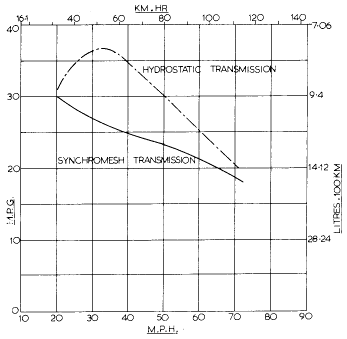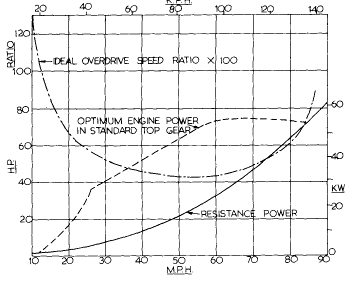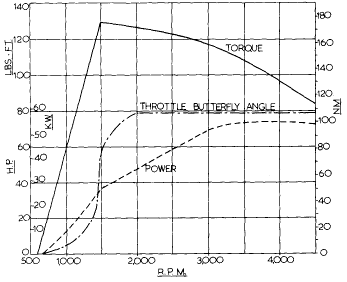| |
| The Ideal Ground Vehicle
Transmission |
All practical ground vehicles are propelled by mechanical power at the wheels or tracks. So, putting aside land yachts and jet propelled speed record seekers, there needs to be some form of transmission providing the necessary wheel torque and speed.
All powered vehicles rely on chemical energy sources, being generally a combustion fuel (gasoline, diesel), or electrochemical (battery, fuel cell). A converter such as an engine or electric motor outputs mechanical power in the form of a rotating shaft. The transmission then translates the converter output to the vehicle requirement.
In an ideal system, by my definition, the energy converter should be designed simply to convert the chemical energy to mechanical energy as efficiently as possible, and with a minimum of pollution where this is an issue.
It is then the task of the transmission to to take whatever speed and torque is output from the converter and efficiently change it to the speed and torque required at the wheels.
Auto industry speak often talks in glowing terms of a “torquey” engine, and the provision of a good torque band is perceived as an essential requirement. And it is always the case that the efficiency potential of the engine is compromised to provide the torque. To my mind this is simply a load of old codswallop. An engine only needs torque to make up for the deficiencies of a poor transmission, otherwise it could provide the power at whatever torque and speed provides the greatest efficiency in energy conversion.
IGVT definition:-
The Ideal Ground Vehicle Transmission
has a continuous ratio capability sufficient to match the torque and
speed of the energy converter operating at its point of maximum
efficiency for the prevailing power demand to the requirements at the
vehicle wheels, over the full range of vehicle performance.
This is not a new idea, but I still read such statements as “diesel engines have superior torque characteristics to spark ignition engines”. So what! Use a better transmission and it does not matter. As we are running out of low cost diesel fuel, this is probably a very good thing.
The Drover Transmission
“The Drover Transmission” is a paper describing the work of Dick Ifield and his development team in producing a hydrostatic transmission that achieved IGVT status in 1962. It consisted of a variable hydraulic pump driving a variable hydraulic motor, replacing the standard transmission of a Rover motor car.
The control system held the engine at the appropriate speed for the prevailing power demand.
|
| The control curve was derived from the
BMEP map of the engine to achieve the highest possible fuel efficiency
at all power levels, commensurate with engine smoothness and
reliability. There was a demonstrable improvement in fuel economy, even as compared with the standard manual transmission in top gear – direct drive. |
 Fuel economy improvement shown by Drover transmission And this with an engine developed to
give torque, not maximum fuel efficiency.
|
Launch from standstill At the moment of launch from standstill, the vehicle is stationary so there is no power required at the wheels, simply the launch torque. The energy converter should only need to provide enough power to cover the efficiency losses in the transmission and drive train. Geared transmissions rely on a slipping clutch or torque converter so that the engine can be run at near maximum torque, to provide the launch torque through the gear reduction. This is both very inefficient and one of the main reasons that engines have to be developed to have good torque characteristics. An IGVT, on the other hand, provides the launch torque without any need for engine torque. A hydrostatic transmission of the Drover type can provide full launch torque with a torque ratio of 1:20, so that the engine can be just above idle speed. The hydrostatic transmission is unique in that it can provide static torque with no dynamic losses, simply a small amount of internal leakage and friction loss. Electric motors are faced with the fundamental physics of torque being proportional to current. Certainly there are things that can be done with current transforming (cryogenics?) but the HST achieves the same with simple mechanical technology. Just cruising At the other end of transmission ratio, level cruising at normal highway speeds only needs a fraction of the engine power of most automobiles, so the best fuel economy is only achieved with very high overdrive ratios. The Rover car used for the Drover transmission needed a maximum speed ratio of 1:2.5 to optimise fuel efficiency over the range of speeds. This was the major factor in providing improvements in fuel economy at steady speed. |
 Transmission ratios for optimum engine utilisation |
| Modern automobiles have a greater power
to weigh ratio, so there is an advantage with overdrive ratios to 1:4.
A Drover style transmission can provide this with about 80% overall
efficiency. The combination of torque ratio at launch and speed ratio at cruise leads to an overall ratio change of 80:1. This is basic for the IGVT concept. Transmissions with less capability simply cannot hack it. From my knowledge this leads to two candidates – hydrostatic or electrical. The hydrostatic excels at the torque end while the electrical has potential advantage at high speeds (perhaps there is a slot here for a hydrostatic/electric split drive that takes advantage of both). Driving without fuss The downside of the high overdrive transmission is that the engine is always at full throttle, this being the condition for maximum fuel efficiency. So any acceleration requires a change in ratio, with the engine speeding up to provide the new power demand. This infers a time lag – sluggish response, definitely a no-no. This is one of the drivers towards larger engines in modern vehicles as there is a need for spare torque, even in overdrive, if drivability is not to be adversely affected. Perhaps the majority of modern automobiles have a theoretical top speed of more than 200 km/hr (125 MPH); partly to provide good acceleration at more modest speeds, but mostly to provide ease of driving with minimum fuss. The IGVT answer to this is energy storage. A small amount of storage can provide the energy for instant acceleration and bringing the engine up to the new speed. Even faster response than existing fuel injected engines. Energy storage is also a requirement for many strategies in improving fuel economy, as will be discussed later. The IGVT definition is extended to meet this requirement:- Further, the Ideal Ground Vehicle Transmission
has the ability to integrate high power energy storage into the drive
train.
Only a relatively small amount of energy is required to provide drivability with high overdrive ratios, readily provided by a small accumulator for hydrostatic transmissions. An electric hybrid could use capacitance storage. Energy storage for improving fuel economy It is now well established that energy storage can be used to improve fuel economy. Electric battery storage is an obvious first choice, but unfortunately not ideal because of their poor performance at high power levels. Batteries have good energy density (can store lots of energy) but poor power density (have poor efficiency at high power). Generally the batteries in electric hybrid vehicles store much more energy than is required to optimise fuel economy, because the are sized to provide the necessary power without too much loss; a very difficult compromise. Ron Kepner’s paper (SAE Paper 2002013128) on the Ford “Hydraulic Power Assist” demonstration vehicle shows that energy storage with hydraulic accumulator can provide useful economy improvements, even without using an IGVT, still using a standard automatic transmission. The use of a full IGVT would further improve fuel economy, and over a wider range of performance. The next major step is to cycle the engine on and off so that it is never idling, but only used to provide power at a level where combustion efficiency is high. This is effectively treating the engine like a battery, switching it off when no energy is required. However, the energy storage system has to store more energy to provide reasonable cycling times, and also to handle that energy hungry auxiliary called the air conditioner. With present vehicles, being comfortable in a traffic jam on a hot day is very inefficient in fuel usage. The hydraulic accumulator becomes too large and heavy. A combination of battery and capacitance storage is one approach. A flywheel is probably the smallest and lightest. Incorporating a flywheel into a hydrostatic IGVT needs a third pump/motor unit to drive it. More complication and cost. But simple established technology with efficient high power capability. The contenders There are basically three contenders for the IGVT:-
Obviously, I am an advocate of the hydrostatic approach, but this will not be achieved without serious commitment. It will not simply be a matter of adapting existing mobile hydraulic equipment to automotive use, as the background of development is simply to different. As far as I know, only the Ifield design was specifically developed for automotive applications, and it shows. The basic philosophy is different. The concentration on part power efficiency for example, as this is where vehicles spend most of their lives. Taking the Ifield concept as a starting point, the challenge is to complete the journey to success. |
